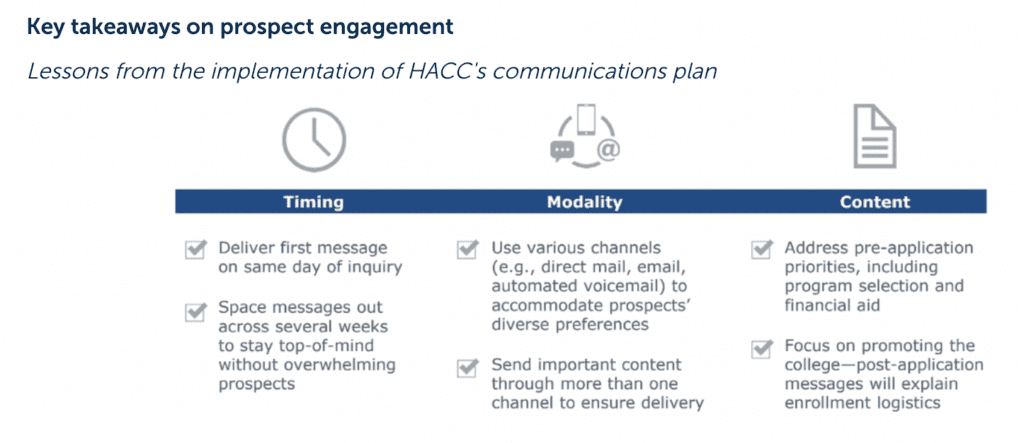How to engage more community college prospects amid the “great opt-out”
As the number of traditional-aged students continues to decline, community college leaders must focus on enrollment and recruitment strategies within their control. One thing is clear—the shrinking birth rate, declines in young adult enrollment, and growing skepticism of higher education makes each interaction with a prospective student more important than ever.
When I worked in enrollment management, inquiries were one of the most difficult categories of students to capture and communicate with. Inquiry cards at community events, referrals from high schools, online information forms and direct emails to our admissions office, were only a portion of the ways students could raise their hands to let us know they were interested in us. Unfortunately, these inquiries and interactions weren’t always tracked, and students received slow, ad hoc responses. Or, even worse, they fell between the cracks and never received any follow up.
-
8,000,000
Source: EAB analysis of American Community Survey data
In this post, I’ll discuss why better recruitment management is so important—especially today—and offer three recommendations to help you start to reframe your recruitment management strategy.
The case for better recruitment management
Increasingly, community colleges are prioritizing high school relationships, investing in marketing strategies, and growing their digital footprint. While modernizing recruitment practices is critical, these strategies are only effective if the college has a strong strategy to engage prospective students. But this is easier said than done, given these pitfalls in our current practices:

Lack of follow up is detrimental, and research shows that mail and email follow up are important to prospective students. An uptick in Gen Z student engagement with email and personal letters is supported by EAB marketing data showing that these sources remain effective communication channels, counter to pronouncements about “the death of email.”
 Additionally, our research shows that when researching post-secondary education lower-income students are less likely to rely on parental support than higher-income students, as are Black or Hispanic students compared to Asian or White students. Knowing that these students are highly represented in community colleges means that prospects are likely looking to the college as their main reference point when exploring their enrollment options, so coordinated email communications are critical to closing equity gaps.
Additionally, our research shows that when researching post-secondary education lower-income students are less likely to rely on parental support than higher-income students, as are Black or Hispanic students compared to Asian or White students. Knowing that these students are highly represented in community colleges means that prospects are likely looking to the college as their main reference point when exploring their enrollment options, so coordinated email communications are critical to closing equity gaps.
So, what can you do to manage your follow-up with prospects more effectively?
3 steps to update your recruitment management strategy
1. Identify prospect entry points
Many community colleges have informal lists of inquiries who have made contact with the college in the past, but not all institutions have a formal structure to respond to, and track, people who are interested in the college. Interested students rarely take a straight line right to an admissions application and may leave other clues that they are interested in the college that can be consolidated into your recruitment management strategy. Not capturing these leads is a missed opportunity in creating relationships with students, and prevents you from maximizing your recruitment investment.
Inquiries and prospects could appear in these places (click to expand):
- Request for information forms
- People who engaged with an online chat tool
- Inquiries to your admissions email inbox
- Guests who attended open houses, or other campus events
- Walk in prospects who engage with your admissions office
- Dual enrollment students who did not reenroll as a degree seeking student
- Call center inquiries
- ISIRs with no admissions application
- Participants in summer programs, both credit and on credit
- Participants in GED and adult education courses
- Leads from workforce and employer partners
- SAT/ACT lists
- Data sharing agreements with feeder high schools
- Referrals from high school guidance counselors
- Referrals from social services agencies and community-based organizations
- Students who started an admissions application but did not complete
- Lapsed applicants who applied but did not enroll
- Community members who leverage career services resources
- Community members who leverage community college resources that are sometimes public facing, like libraries, fitness centers, or child care centers
- Guests who engage in social events on campus, like concerts and art exhibitions
Consolidating your leads into a centralized repository that tracks the origin of the lead and characteristics of the prospective student allows your college to route prospective students into more robust communications flows. This reduces the likelihood that interested students will fall through the cracks.
2. Audit your current practice
Once you’ve identified where your interested students are coming in, the next step in creating an impactful campus communications strategy is to audit your current practices. We recommend the following steps, outlined in our Integrated Prospect Communication Plan Toolkit, to take inventory of your current strategy and to develop communications philosophy:
- Laying the groundwork: In this phase, enrollment managers secure buy-in from campus leadership for a comprehensive audit of all outbound student communications. They also consider the scope of the audit and the personnel necessary to make it successful. Specifically, enrollment leaders build a business case and select committee members for the initiative.
- Conducting an audit workshop: In this second phase, enrollment managers prepare and execute the communication audit workshop, and lay the groundwork for a campus-wide integrated communication plan. The participants required for this phase are members of the cross-functional planning committee. This group develops prospective student personas, visual representations of current communications flows, guidance on which communications are kept, and prototypes of aspirational communications flows.
- Enhancing audit approved communications: After the audit, the committee takes a closer look at the revised communications that will go out to students and parents, editing them for value and readability. Specifically, teams can use our editorial checklist and check for jargon to make sure communications are student centered, easy to read, and aligned with institutional goals.
By moving through this “cleaning” process of your current communications you may also identify gaps in communications that require new email, text, or mail templates. These new communications, which should be short and have clear calls to action, can be folded into your plan after your initial audit.
3. Create a centralized communications calendar
Once you’ve audited your current practice and identified where your prospects are coming from, standardize your communications by creating a year-round calendar. By developing touchpoints prospects receive in a “drip” marketing campaign after they submit an inquiry but before they apply your college can increase your prospect to applicant conversion rate.
These systems allow institutions such as Harrisburg Area Community College (HACC) to engage prospects through standardized communications plans. For example, every prospective student who inquires at HACC receives 11 automated messages through email and direct mail. These communications span a three-month period and follow a pre-determined timeline.

Unlike ad hoc messages, a standardized communications plan allows colleges to optimize each touchpoint in advance. Before administrators at HACC developed their communications plan, they conducted focus groups with current and prospective students to determine the ideal timing, modality, and content for their messages. The graphic below summarizes their key findings. First, the initial message should occur on the same day a prospect inquires, and subsequent messages should span several weeks or months. Second, staff should send important messages through multiple channels to reflect prospects’ diverse communication preferences.

Finally, prospect communications should emphasize the college’s value proposition. Unlike the largely logistical messages that go out to applicants, messages to prospective students who have not yet applied should focus on promoting the college as a destination of choice.
By leveraging a set communications plan and calendar, HACC increased inquiry to application rates by 9% within two years, helping more students reach their academic goals and driving enrollment targets for the college.
In conclusion
As participation in higher education continues to decline, especially among Gen Z, a strong prospect engagement strategy increases the likelihood that a student will enroll at your college. With a strategy in place, you can begin to capture more of your prospective students earlier, easier, and with less lift.

More Blogs

What enrollment leaders can learn from Alabama’s statewide direct admissions program

4 questions domestic students will ask before applying to your graduate program
